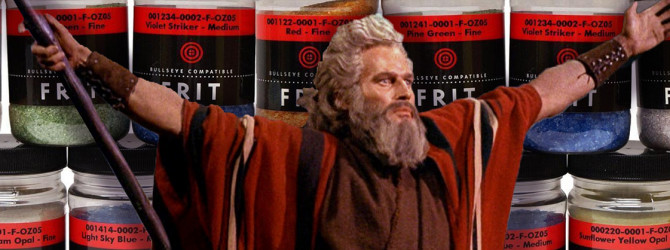
Paul’s 10 Commandments of Fused Glass
 Glass fusing experience is measured by number of kiln firings, not years. You get double credit for experimenting – which you should do continually. Your glass scraps and kiln shelf margins can teach you more than any class or book.
Glass fusing experience is measured by number of kiln firings, not years. You get double credit for experimenting – which you should do continually. Your glass scraps and kiln shelf margins can teach you more than any class or book.- Your success (or failure) is a product of two things: What you do at the table AND how you fire it. Until you are programming the kiln you are at the mercy of the person who is.
- No matter how experienced you are, how smart you are or how lucky you are, your work will occasionally break during firing. Take the time to understand what went wrong and don’t mourn the shards of glass in your kiln. They will make nice jewelry for your mother-in-law.
- Avoid any teaching studio that doesn’t fully explain firing schedules, annealing, thermal shock, and devitrification in their beginner class. Anyone who doesn’t have a deep understanding of these things has no business teaching glass kilnforming.
- The pen and digital camera are indispensible tools for the fused glass artist. Take pictures and notes of what you do and the results. Even if your memory is great today it won’t always be that way. If you don’t believe me, ask anyone (else) who is over 40.
- As you learn, share your knowledge. If you think you’ve invented something new you almost certainly haven’t. If the value of your work is founded on a proprietary technique then you may be a good technician but that doesn’t make you a good artist.
- Almost all fused glass failures are caused by doing something faster than you should have done it.
- Use long, slow bubble squeezes generously. The kiln gods love the temperature range between 1100° and 1250° F and they will reward you for languishing there on the way up.
- Anneal for a thicker piece of glass than you are firing. Most published schedules are based on math that assumes the glass is cooling evenly from all sides. This assumption is false since glass cools more slowly where it rests against the kiln shelf.
- The secret to being a successful glass artist is to approach fusing like you would sex: compatibility matters, use good hygiene or you’ll end up with something cruddy, slower is always better, treat the glass with respect or it will hurt you, and you know it was a success if there is no stress when you are finished.
[button link=”/wp-content/uploads/downloads/ten_commandments.pdf” color=”limegreen” size=”small” target=”_blank”]Download printer-friendly version[/button]